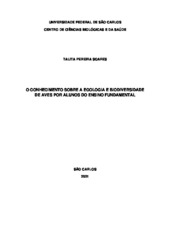| dc.contributor.author | Pereira Soares, Talita | |
| dc.date.accessioned | 2022-09-16T12:58:59Z | |
| dc.date.available | 2022-09-16T12:58:59Z | |
| dc.date.issued | 2021-07-05 | |
| dc.identifier.citation | PEREIRA SOARES, Talita. O conhecimento sobre a ecologia e biodiversidade de aves por alunos do ensino fundamental. 2021. Trabalho de Conclusão de Curso (Graduação em Ciências Biológicas) – Universidade Federal de São Carlos, São Carlos, 2021. Disponível em: https://repositorio.ufscar.br/handle/ufscar/16627. | * |
| dc.identifier.uri | https://repositorio.ufscar.br/handle/ufscar/16627 | |
| dc.description.abstract | The human impact are increasingly intense worldwide, demanding a new attitude from society in relation to the environment. In Brazil, a relationship of greater concern with environmental issues has been growing over the last years. Thus, the importance of having environmental education teaching in scholar curriculum increases in order to create critical and reflective citizens capable of finding a way to reduce the human impact on the environment. This is the objective of Environmental Education in schools, but this theme is still underdeveloped, with a great distance between people and the reality on the ground. Likewise, the popular knowledge of students is little explored in general themes when it comes to the subject of ecology and biology of birds. The objective of this study was to address the knowledge of bird ecology and biology in the seventh year of the elementary school in a state public school in São Carlos, São Paulo state, Brazil. I applied a questionnaire containing subjective and objective questions evidencing the knowledge of the birds of each student. When analyzing the obtained responses, I found that the students had a reasonable knowledge on bird names. Analyzing the answers on bird species identification based on their pictures, in relation to the species cited by them, I noticed that many students could not identify the species cited in the previous question. However, when assessing the questions on the characteristics on the species and their biology, I realized the poor knowledge of the students, which did not corroborate the responses to the questions on identification and citation of species names. This study suggest that better results can reach if the students have an approximation to the ecological and biological concepts that involve their popular knowledge about birds, embracing other curricular topics. In this way, we can build a way in which this generation has a greater understanding of the anthropic impacts that have been happening over thousands of years and how they can change this scenario. | eng |
| dc.description.sponsorship | Não recebi financiamento | por |
| dc.language.iso | por | por |
| dc.publisher | Universidade Federal de São Carlos | por |
| dc.rights | Attribution-NonCommercial-NoDerivs 3.0 Brazil | * |
| dc.rights.uri | http://creativecommons.org/licenses/by-nc-nd/3.0/br/ | * |
| dc.subject | Educação ambiental | por |
| dc.subject | Etnoornitologia | por |
| dc.subject | Questionário | por |
| dc.subject | Environmental education | eng |
| dc.subject | Ethno-ornithology | eng |
| dc.subject | Questionnaire | eng |
| dc.title | O conhecimento sobre a ecologia e biodiversidade de aves por alunos do ensino fundamental | por |
| dc.title.alternative | Knowledge about the ecology and biodiversity of birds by elementary school students | eng |
| dc.type | TCC | por |
| dc.contributor.advisor1 | Sarmento, Hugo | |
| dc.contributor.advisor1Lattes | http://lattes.cnpq.br/4515469289999439 | por |
| dc.contributor.advisor-co1 | Batisteli, Augusto | |
| dc.contributor.advisor-co1Lattes | http://lattes.cnpq.br/2107797655834765 | por |
| dc.description.resumo | Os impactos antrópicos são cada vez mais intensos a nível mundial, exigindo uma nova postura da sociedade em relação ao meio ambiente. No Brasil, uma relação de maior preocupação com questões ambientais vem crescendo aos longos dos anos. Com isso, aumenta a importância de termos nos currículos escolares o ensino de educação ambiental para criarmos cidadãos críticos e reflexivos capazes de encontrar uma maneira de diminuir o impacto humano no meio ambiente. É esse o objetivo da Educação Ambiental nas escolas, porém esse tema ainda é pouco desenvolvido, havendo grande distanciamento entre as pessoas e a realidade no terreno. Da mesma forma, o conhecimento popular dos alunos é pouco explorado em temas gerais quando se trata do assunto de ecologia e biodiversidade das aves. Este estudo teve como objetivo analisar o conhecimento da biologia e ecologia das aves no sétimo ano do ensino fundamental II em uma escola de ensino público em São Carlos, Estado de São Paulo, Brasil e assim mostrar que durante o ensino das aves nas escolas, ele aparece de forma defasado, porém foi possível observar respostas que mostraram conhecimento prévio sobre o assunto. Para isso, utilizou-se um questionário como forma de coleta de dados contendo questões subjetivas e objetivas, evidenciando o conhecimento sobre as aves de cada aluno. Ao analisar as respostas obtidas, observamos que os alunos possuem um conhecimento razoável sobre nomes das aves. Analisando a questão sobre identificação de aves através de sua imagem, em relação às espécies que foram citadas por eles, percebi que muitos alunos não conseguiram identificar as imagens mesmo citando a mesma espécie na questão anterior. Porém, quando analisei, as questões sobre as características das espécies e sua biologia, percebi o pouco conhecimento dos alunos, o que não condiz com as respostas dos alunos nas questões de identificação e citação das espécies. O estudo sugere que melhores resultados podem ser obtidos se os alunos tiverem uma aproximação dos conceitos ecológicos e biológicos que envolvam seu conhecimento popular sobre as aves, conseguindo abranger outros temas curriculares. Assim, poderemos construir uma maneira na qual essa geração tenha um entendimento maior dos impactos antrópicos que vem acontecendo ao longo de milhares de anos e como eles podem modificar esse cenário. | por |
| dc.publisher.initials | UFSCar | por |
| dc.subject.cnpq | CIENCIAS HUMANAS::EDUCACAO::ENSINO-APRENDIZAGEM | por |
| dc.publisher.address | Câmpus São Carlos | por |
| dc.publisher.course | Ciências Biológicas - CB | por |

